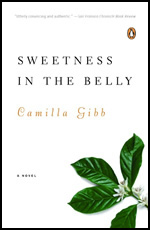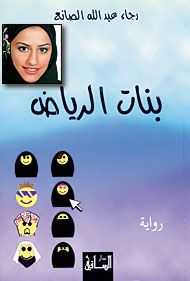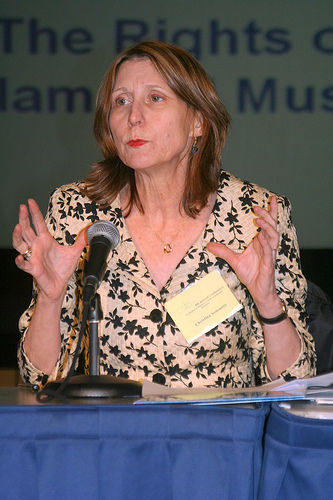Sep
4
Your Grandmother’s Islam: Can Religion Be Separated from Culture?
September 4, 2007 | 1 Comment
Quick, identify this scene: At dusk, believers flock to a shrine, following the pounding of drums. They come to hear the rhythmic chanting of a living saint. A leafy stimulant is passed around, and the men and women chew it until they reach a transcendent state, rocking and dancing and chanting along with their leader until, exhausted, they collapse at dawn.
Is it a Native American ritual? An ancient Christian cult? A Grateful Dead concert? No, it’s Islam — as practiced several decades ago in Harar, Ethiopia, where hundreds of shrines dot the ancient walled city and men and women chew qat leaves for relaxation and religious inspiration.
 This description of Thursday night ritual worship comes from Sweetness in the Belly, a novel, released earlier this year in paperback, by anthropologist Camilla Gibb. The novel follows the story of Lilly Abdal, an orphaned British girl raised as a Sufi Muslim in North Africa, as she creates a life for herself in traditional Harar, only to ripped from the city during the 1974 overthrow of Emperor Haile Selassie’s regime.
This description of Thursday night ritual worship comes from Sweetness in the Belly, a novel, released earlier this year in paperback, by anthropologist Camilla Gibb. The novel follows the story of Lilly Abdal, an orphaned British girl raised as a Sufi Muslim in North Africa, as she creates a life for herself in traditional Harar, only to ripped from the city during the 1974 overthrow of Emperor Haile Selassie’s regime.
While the novel delicately traces the haunted emotion of refugee life — Lilly cocoons herself with fellow Ethiopian exiles in London — it also tells a religious story. Lilly starts out as a thoroughly traditional North African Muslim girl: She memorizes Qur’an with the Sufi master who has adopted her and obediently accepts the insular, male-dominated world around her.
As a teen-ager, she lives with a poor family in Harar, teaching the children to memorize the Qur’an while performing the everyday tasks of poverty and tradition: hauling water, grinding grain, visiting neighbors and honoring the saints. Her world expands when she falls for a doctor at the nearby hospital and is led toward the sins of hand-holding, kissing and more. Just as she is struggling to reconcile her haraam longings with her narrow religious devotion, she suddenly finds herself uprooted and dropped, a stranger, into London.
Lilly works to keep the religion and ritual she knows: burning incense to lift prayers to the saints, caring for fellow Ethiopians and immigrants who need help. But the religion she finds at the mosques in Britain is strange to her:
This is what happens in the West. Muslims from Pakistan pray alongside Muslims from Nigeria and Ethiopia and Malaysia and Iran, and because the only thing they share in common is the holy book, that becomes the sole basis of the new community; not culture, not tradition, not place. The book is the only thing that offers consensus, so traditions are discarded as if they are filthy third-world clothes. “We were ignorant before,” people say, as if it is only in the West that they have learned the true way of Islam.
Lilly refuses to accept the strict, Wahhabi-inspired preaching she hears at the London mosques, where the Sufism she practices is derided as superstition and wrongful religious innovation. Instead she moves toward a quasi-secular spirituality, still attached deeply to her tradition, yet allowing herself to love and maybe marry a Hindu man — something forbidden by the religious law she once embraced unquestioningly. For Lilly, religion is embedded in the smells and dust and laughter of a particular place and time. Unlike fellow Muslims in Britain, she is unwilling to simply extract the theological commonalities and distinguish between “true Islam” and “mere culture.”
In this sense, Lilly rejects the globalized, homogenized Islam she sees in the West. She belongs to a religion of the particular, of the past, and when those traditions can’t fit into her new, Western life, she lays them lovingly to the side.
Although Lilly’s voice exists loudly in this novel, it is but a small peep in the religious marketplace of Islam today. Wahhabi or not, many if not most Western Muslims adhere to the idea that cultural practices must be stripped from the religion to reveal a pure, true core — the essence of faith. The weakness of this approach has been well-argued by Dr. Umar Farooq Abd-Allah, a long-time American convert to Islam (see his article, “Islam and Cultural Imperative.”) This voice, however, remains a minority, and the remnants of an Islam rooted in place and time may be found, in the West at least, only among the older generation, who sit quietly in the corner, whispering to the saints.
Aug
13
Romeo and Juliet in Saudi Arabia, and Romeo’s a big disappointment
August 13, 2007 | 1 Comment
Get on a plane to Riyadh, Saudi Arabia. Rent a house, find a job, settle in. Learn Arabic, make friends, spend years in the country. Still, you will never get as full a glimpse into the lives of young urban Saudi women as you will from reading Rajaa AlSanae’s novel, Girls of Riyadh, published in English this month by Penguin.
Written by a young 20-something Saudi woman, now studying dentistry in Chicago, the book was first published in Lebanon in Arabic (Banat Ar-Riyadh) in 2005, evoking a firestorm of debate and criticism around the Arab world and, of course, in Saudi Arabia, where it was originally banned and where a group of Saudi citizens filed suit against the author for slandering Saudi society.
For ReligionWriter, who recently spent two years living in Muscat, Oman, the details of life on the Saudi peninsula were perfectly evoked: the elaborate sex-segregated wedding celebrations, the text-messaging-based culture of the young urban elite, the desperate practice of young men “numbering” young women (i.e. throwing their phone numbers at women they glimpse but are unable to socialize with because of social norms.) But because the book’s author is a Saudi woman herself, the book brings the reader far past the Lonely Planet-type descriptions of cultural context: Al-Sanea shares with us the story of four young women as they search for love in a culture where family-approved marriage often wins the day.
 (Left: The book’s Arabic edition, with an inset of the author. Note the culturally appropriate emoticons at the bottom.)
(Left: The book’s Arabic edition, with an inset of the author. Note the culturally appropriate emoticons at the bottom.)
The stories themselves are as entertaining, if not more so, than any episode of “Sex in the City.” One character is married off to a successful young Saudi living in the U.S., who, it turns out, is in love with an Asian-American woman his family forbid him from marrying. Two other characters fall in love with men unable to buck their families insistence that they marry a certain kind of girl — that is, one from the “right” family with the “right” reputation. At moments, the reader might feel like they are reading about Western culture in an earlier era, when being divorced was a stigma a woman could almost never live down, when a young adult woman with no parents was forced to move in with relatives rather than risk the “scandal” of living alone.
But more than anything the stories evoke the timeless story of Romeo and Juliet — two lovers separated in no uncertain terms by their determined families. That story’s romance lies in the commitment both characters have to their love and their vision of living out that love in real life. In AlSanea’s stories, however, Romeo appears sadly lacking in such a commitment. AlSanea portrays most, though not all, of the young Saudi men in her book as, in the words of one of the female protagonists, “passive and weak.” This woman, Mashael, who dumped the love of her life when he confessed that his mother disapproved of their romance and would not allow them to marry, had this to say of Saudi men:
They are slaves to reactionary customs and ancient traditions even if their enlightened minds pretend to reject such things! That’s the mold for all men in this society. They’re just pawns their families move around on the chessboard!
But the book is not without hope: one character, at least, is married to a Saudi man who loves and respects her. And while some critics have savaged the book’s main characters, saying these upper-class young women seek only the frivolity of passionate love, the author suggests that love is a force powerful enough to change a society so resistant to change.
For a Western audience, the book is a first-of-its kind, and its value lies in introducing readers to this unfamiliar world that is surprisingly familiar. As the author writes in her forward to the English edition:
I hope by the time you finish this book, you will say to yourself: Oh, yes. It is a very conservative Islamic society. The women there do live under male dominance. But they are full of hopes and plans and determination and dreams. And they fall deeply in and out of love just like women anywhere else.
Related elsewhere: “‘Girls of Riyadh’ spurs rush of Saudi novels,” Reuters, June 23, 2007
Jul
18
What Would Prophet Muhammed Eat?
July 18, 2007 | 4 Comments
 Given that some American Protestants are finding dietary inspiration from Jesus, it seems only fitting that American Muslims might look to the Prophet Muhammed for inspiration to lose weight, eat healthy and fight the obesity epidemic. After all, evidence of Jesus’ diet in the Gospels is thin, and the Last Supper’s bread and wine is pretty carb-heavy, but that hasn’t stopped people like Gwen Shamblin from creating a complete — and megasuccessful — faith-based weight-loss program.
Given that some American Protestants are finding dietary inspiration from Jesus, it seems only fitting that American Muslims might look to the Prophet Muhammed for inspiration to lose weight, eat healthy and fight the obesity epidemic. After all, evidence of Jesus’ diet in the Gospels is thin, and the Last Supper’s bread and wine is pretty carb-heavy, but that hasn’t stopped people like Gwen Shamblin from creating a complete — and megasuccessful — faith-based weight-loss program.
Muslims can find very specific dietary advice in the prophetic traditions, or hadiths. The voluminous collections of hadiths are the equivalent of the Muslim Gospels, since both record the sayings and doings of Muhammed and Jesus, respectively.
This morning, ReligionWriter sat down with vol. 7 of the English translation of the hadiths collected by Al-Bukhari to read the “Book of Meals.”
The first answer to the question “What would Prophet Muhammed Eat?” is: Not much. He shared his food with others, and many of the stories about him and his companions refer to periods of extreme hunger. The prophet lived the dietary life of a poor man; as one companion put it, he did not see “well-baked bread” or a full roasted sheep “until he met Allah” (i.e. died.)
Muhammed was a great proponent of portion control. According to Abu Huraira, the Prophet said: “The food for two persons is sufficient for three, and the food of three persons is sufficient for four persons.”
The Prophet’s comment that “a believer eats with one intestine, while an unbeliever eats with seven intestines” advocates a kind of will-power-induced stomach staple.
And here’s one for Muslim mothers with picky-eater children: Abu Huraira narrated that Muhammed “never criticized any food (he was invited to.)” Rather, he would eat the foods he liked and simply leave the foods he did not.
White flour? Not for Muhammed. One of his companions related that the prophet only ate bread made from unsifted barley flour with the husks blown off.
But before he sounds too perfect, the prophet’s favorite wife, Aisha, testified that he also had a sweet-tooth, enjoying honey and other edible treats.
The field is open for an American Muslim to write the first Prophet Muhammed-based diet. Good luck to you!
Apr
30
Scholar: In Islamic Feminism, Both Liberals and Conservatives Play Essential Roles
April 30, 2007 | Leave a Comment
 (Left: Christina Hoff Sommers speaking at Friday’s conference, “The Rights of Women in Islam and Muslim Societies.” Photo by Andrea Useem)
(Left: Christina Hoff Sommers speaking at Friday’s conference, “The Rights of Women in Islam and Muslim Societies.” Photo by Andrea Useem)
In the struggle to accord women more rights in Islamic law and culture, who can play the most effective role? Christina Hoff Sommers, an American Enterprise Institute resident scholar speaking last Friday, pointed to the experience of American suffragettes to argue that while secular-minded liberal women couched the struggle in terms of appealing universal-rights language, it was the religious-minded conservatives who made the message stick among the masses. Sommers was speaking at a one-day conference, sponsored by the Washington D.C.-based Center for the Study of Islam and Democracy, which focused on the rights of women in Islam and Muslim societies.
Sommer’s argument: “Roughly speaking, there were two styles of feminism that flourished in the 19th and early 20th century in the
“Anthony and Stanton, inspired by Enlightenment ideals and the principles of equality enshrined in the Constitution, couched the women’s struggle in appeals to universal rights,” she said, yet they watched their movement fail to gain traction. “Their style of enlightened feminism was not able to galvanize sufficiently large majorities. Overall, it was — heartbreakingly to them — ineffective with women,” said Sommers.
How then did women win the vote in 1920?
“It was primarily due to a second group of feminist who were able to win the hearts and minds of average Americans, especially women,” said Sommers. Francis Willard “reached out to devoutly religious women who found feminism alienating or irrelevant, or a threat to their femininity or their place in the family. She practiced a form of Christian ijtihad,” using Scripture to support an active role for women, said Sommers.
“She had a genius for harnessing powerful conservative currents in the culture and directing them to progressive ends,” said Sommers.
A later generation of feminists, following in Willard’s path, “persuaded American women that voting and political engagement was their moral duty as women and mothers. They feminized the political domain,” she said.
“Most historians would agree: both groups were essential to women getting their rights. The Enlightenment feminists provided the leadership, the inspiration, the new ideals, and they were bold and aggressive — in some cases they would do crazy things. The conservative feminists found sources for those ideals in their own traditions. In the end it was they who galvanize an entire country to amend its Constitution,” she said.
ReligionWriter’s Take-Away for Journalists: While headline-grabbing but polarizing figures like Asra Nomani, Irshad Manji, and Ayan Hirsi Ali have struck rhetorical blows for women’s rights, it may be mainstream change-leaders like Ingrid Mattson and Azizah Al-Hibri who make those gains stick.